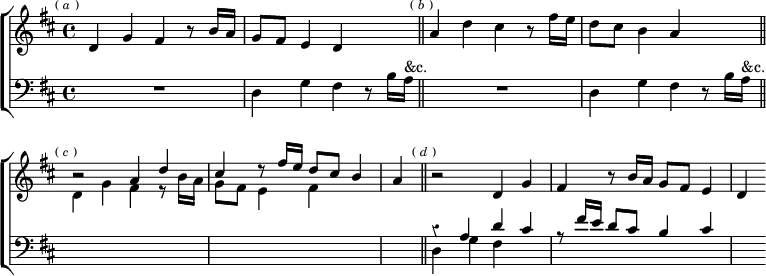§§ 194, 204, it did not happen to occur to us to make one which would be suitable for stretto afterwards. Consequently, though it is quite possible to introduce later entries at a shorter distance than two bars, these will not be so effective, nor flow so naturally as if the subject had been written with this object in view. We give a few stretti as illustrations.

248. These examples, which must not be regarded as models of a good stretto, but are written to show that a stretto of some kind is mostly possible even for a subject not at first designed for it, illustrate several points relating to its construction. We see at (a) a case of common occurrence. Here the imitation is not in the fourth or fifth, but in the octave. As a matter of fact, the imitation in a stretto may be at any interval, though in general those in the fourth, fifth, and octave will be found the best. At (b), as at (a), the imitation is at one bar's distance; but it is here in the fifth below; the answer leads, and the subject replies. The imitation of the answer by the subject often gives a different set of combinations.
249. At (c) the subject leads and the answer replies at half a bar's distance. The consecutive fourths between the first and second bars are bad, as they stand;. but a stretto for two voices, like a two-part double counterpoint, is mostly accompanied by free parts. Here we have left the bass staff empty, instead of putting rests, to show that a bass is meant to be added, which will make the fourths right. Observe that the last note of the subject has to be changed here, to avoid consecutive octaves.
250. Our last stretto, at (d), is also the closest. It is for three voices at one crotchet's distance. It is evident that now the bass cannot possibly complete the subject; it will therefore have to continue with a free counterpoint, which we have purposely not filled in, so as to show only the close imitations. The middle voice now has the subject, per arsin et thesin, and, as at (c), the last note requires to be altered.
251. Before writing a subject specially to show the different possibilities of stretto, it will be well to give a few general hints
